George J. F. Clarke
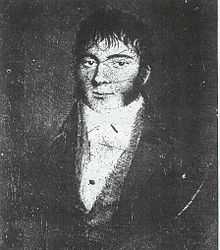
George J. F. Clarke (1774-1836) was one of the most prominent[1] and active men of East Florida in the Second Spanish Period. As a friend and trusted advisor of the Spanish governors of the province from 1811 to 1821, he was appointed to several public offices under the colonial regime, including that of surveyor general.[2] Clarke served in the Spanish militia from 1800 to 1821, defending East Florida in the "Patriot War" of 1812 and leading militia forces against the freebooters Gregor MacGregor and Louis-Michel Aury in 1817. By the order of Governor Enrique White he platted the town of Fernandina in 1811[3] and oversaw the construction of new buildings there. He was a central figure in organizing a local government in the area between the St. Marys and St. Johns rivers, which brought a workable peace to that tumultuous section during the final years of Spanish rule.
Clarke knew the geography of the region better than any other person of his time, as his office was responsible for every land survey made in East Florida between 1811 and 1821. Clarke profited from the acquisition and resale of large tracts of land, and his landholdings were among the largest in Florida. In his will he distributed more than 33,000 acres to his heirs, as well as several houses and scattered lots. He spoke Spanish fluently, but his writing in the language was ungrammatical. His initials have been given incorrectly by many historians as I. F., confusion arising because the capital I's and J's of his handwriting were indistinguishable. His will shows his given name to have been George John Frederic Clarke.[4]
In his later years he invented a horse-driven sawmill, practicable enough that the Spanish Governor José Coppinger granted him a "sawmill grant"[5] of 22,000 acres of timbered land, although the customary such grant was for 16,000 acres.[6][7] He published his opinions on a wide array of subjects in the provincial newspaper, the East Florida Herald, including experimental agriculture, fruit tree cultivation, diet and health, archeology, and the white man's relations with the Indians.
Early life
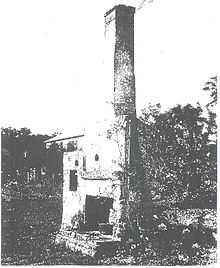
Clarke was born a British colonial subject in St. Augustine, naturalized as a Spanish citizen, and died an American[8] by the terms of the Adams-Onis Treaty, which ceded the Floridas to the United States. He was the son of an English father, Thomas Clarke, Sr., and an Irish mother, Honoria Cummings, who were among the earliest British settlers of British East Florida. His baptismal record in the Cathedral Parish of St. Augustine gives his birth date as October 12, 1774.
Thomas Clarke had obtained by grant or purchase four tracts of land and three houses with their lots in St. Augustine. In 1770 Governor James Grant gave him title to 300 acres on the west side of the Matanzas River,[9] four miles northwest of the Spanish fort at Matanzas inlet, and about ten miles south of St. Augustine. In honor of his native city he called the plantation he established there Worcester.[9]
After Thomas Clarke, Sr. died in 1780, his widow Honoria, a devout Roman Catholic, chose to remain in Florida; she became a Spanish subject following the recession of the province to Spain in 1783,[10] and had her children baptized in the Roman Catholic church. Young George was well-trained in business, his mother having apprenticed him at age twelve to the British trading firm of Panton, Leslie & Company,[11] which dealt with the Indians of Florida and those in the neighboring Spanish-claimed territory.[12]
Plantation on the Matanzas River
Prior to 1802, George, now called Jorge, helped to manage his mother's property. By that year he was living in St. Augustine and served as an ensign in the urban militia. In 1804 he purchased from the Crown a town lot and buildings conveniently located on Marine Street, between the military barracks and the old powder magazine.[13] He and his brother Charles then occupied the family land on the Matanzas River, harvesting and sawing timber trees, as well as gathering oyster shells for their lime kilns. They transported the wood and lime in flatboats sent up the Matanzas River to town, supplying the government with shingles for public buildings, and providing whitewash for the exteriors of houses.[14]
The brothers raised corn, peas, sweet potatoes, pumpkins, and other vegetables, each on his own acreage of the plantation. They lived there for a few years, but as their mercantile and timber interests expanded, with new opportunities for great profits to be made at the free port of Fernandina, they moved their families[15] and slaves in 1808 to the booming community at the north end of Amelia Island. Four freemen were hired to work their acreage on the Matanzas in their absence. "Don Jorge Clarke", his common-law mulatto wife Flora, and four children 7 to 15 years old are mentioned in an entry of the census taken at Fernandina in 1814.[16]
His biracial family
George J. F. Clarke owned ten adult working slaves. Four were women, one of whom tended to his household, and the other three were hired out as laundresses or house servants. The six men labored mostly in his timber business alongside rented slaves and wage-earning freemen.[17] Clarke was among the province's prominent citizens who admitted fathering children by black women, enslaved and free.[18] He lived as husband and wife with Flora Leslie,[19] a former slave whom he had freed,[20] and made their children his heirs, dividing his property among them in his will.[21] He had four children by another black woman named Anna or Hannah Benet after Flora died; they and she were left a legacy of 1500 acres as well.[22]
Service to the Spanish province of East Florida
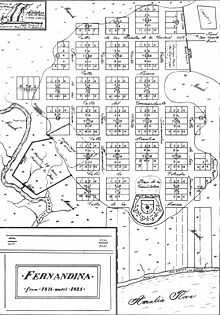
Clarke's first known public service outside the militia was as acting public surveyor in the absence of Juan Purcell.[23][24][25] It is likely he had previously served as deputy surveyor; Purcell's absence was prolonged, and after three years, on May 8, 1811, acting Governor Estrada appointed Clarke Surveyor General of East Florida. There was little supervision from Spain, which was embroiled in the Napoleonic invasion, with its government in exile.[26] Clarke was in complete control of the surveying of land grants in the province, and surveyed many land grants for free blacks and helped them document and retain these grants when the United States finally took over Florida in 1821.[27] After the East Florida revolution of 1812, Fernandina was occupied by US troops and the Spanish citizenry fled; some, including Clarke, suffered damage to their homes and businesses in their absence.
The United States Congress passed the Embargo Act of 1807, and prohibited the importation of slaves in 1808. That same year Fernandina was declared a free port; it began to ship great quantities of Florida cotton and lumber, and became a resort for the smuggling business and contraband slave trade.[28] The town entered a boom period of extraordinary growth, with finer residences and crude shacks springing up next to each other. Vegetable gardens were planted haphazardly about, and the streets were little more than crooked paths. The unsightly and unsanitary condition of Fernandina disturbed Governor White, and on May 10, 1811, two days after Clarke's appointment as surveyor general, he instructed him to plat the town so that the streets were properly aligned and the lots were uniform.[13]
In the Patriot War of 1812 George J. F. Clarke and his brother Charles were among those who most actively opposed the American invaders and their raiding parties into the province. George was in command of one of the two Spanish entrenchments at Fernandina when on March 14 his brother Charles brought word that the rebels had gathered at Low's Plantation on Bell's River to raid Fernandina.[29]
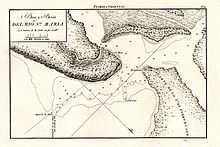
On March 16, eight American gunboats[30][31] under the command of Commodore Hugh Campbell formed a line in the harbor and aimed their guns at the town.[32][33] Clarke and George Atkinson were sent by Justo Lopez, Commandant of Fort San Carlos and Amelia Island, to meet Commodore Campbell on one of the gunboats anchored in the Amelia River and find out his intentions,[34] but Campbell, uneasy about the turn of events, equivocated.[35] General George Mathews, ensconced at Point Peter on the St. Marys in Georgia, ordered Colonel Lodowick Ashley to send a flag to Lopez,[36] commandant of the fort and Amelia Island, and demand his surrender. Lopez acknowledged the superior force and ordered Clarke to go to John H. McIntosh and Col. Lodowick, president and military chief, respectively, of the putative "Republic of Florida", with a flag of surrender,[37] thus turning over the port and the town to the Patriot forces. Along with Justo Lopez, George Atkinson, and Charles W. Clarke, George signed the articles of capitulation on March 17.[38] American forces held Amelia Island “in trust for Spain" until the following spring, and shut off Fernandina harbor to foreign vessels in an attempt to throttle the port's infamous smuggling.
Clarke's main business occupation following the Patriot War was buying and selling lots in Fernandina and lands in other parts of the province. He usually bought the land outright or secured it by grant, and then sought buyers. Sometimes he acted as agent, as he did in the sale of Fort George island in 1816 by John H. McIntosh to Zephaniah Kingsley.
Clarke's last service for the Spanish Crown was as Deputy Governor of East Florida. The colonial administration in Florida had been unstable since the retrocession, due partly to events in Europe—the Napoleonic invasion of the Iberian peninsula, and the revolutionary convulsions in Spain[39] following the restoration of the Bourbons to the Spanish throne. The Spanish treasury was exhausted and the government demoralized. Conditions in the Floridas were unsettled as well with frequent Indian uprisings, the Patriot War, and finally the MacGregor invasion and Louis Aury's occupation. Spanish Florida's main concern, however, was the resolve of the United States to annex it.
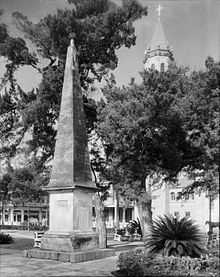
The withdrawal of US troops in May 1813, and the dispensation by Governor Kindelán of local self-government under the new Spanish Constitution of 1812 to the inhabitants of the turbulent districts along the St. Johns and St. Marys rivers and Amelia Island, had little effect on the state of anarchy now endemic to the area, especially around the St. Marys River where the so-called Patriots were determined to preserve the "Republic of Florida". Civil disturbances were prevalent, and the rebellion begun in 1812 persisted until the latter months of 1816, when Governor Kindelán sent Clarke, Zephaniah Kingsley, and Henry Yonge, Jr. to parley with the malcontents and negotiate an agreement by which hostilities might cease.[40] The three commissioners met forty of the rebel leaders at Mill's ferry on the St. Marys and arranged for a general meeting of the men of the region to be convened at Waterman's Bluff in three weeks.[41] Clarke and the other two commissioners went to the meeting and offered terms of peace, proposing that the Patriots abandon their claim to a republic and accept Spanish rule under a plan that divided the territory between the St. Marys and St. Johns into three self-governing districts to be known as Upper St. Marys, Lower St. Marys, and Nassau (Amelia Island). Each district was to have a magistrate's court and its own militia, the officers to be elected by the people.[42] The Patriots accepted these conditions and Clarke's plan was adopted, finally ending the "revolution" after four years of attempts to seize the province by force of arms.[43]
Governor Coppinger approved these proceedings and Clarke's "plan of reconciliation and re-establishment of order",[44] and offered Clarke an appointment to superintend jurisdiction of the division,[45] which he accepted on condition that it be confined to Upper and Lower St. Marys, omitting Amelia Island.[46] Clarke was accordingly commissioned Capitan del partido Septentrional de la Florida del Esta (Captain of the Northern District of East Florida). His obituary notice described him as “Lieutenant Governor of East Florida". He later wrote that in the five years of his tenure in this office there had been only one appeal and one complaint to the authorities in St. Augustine, but admitted that his administration was assisted by "Lynch's Law" implemented by the more respectable citizens.[47]
As Capitan of the "Northern Division" and Lieutenant of the Urban Militia of East Florida, Clarke was of great service to the province during the MacGregor and Aury interlude, and was the prime mover in keeping his section loyal to the Spanish Crown. The three companies of militia called by the governor to defend Amelia Island, consisting of mostly black citizens, were led by Clarke himself.
The Spanish regular officer leading the expedition ordered a retreat, to the disgust of Clarke's men, who returned to their homes. Even so, Clarke worked to impede the advance of the invaders into the province and tried to prevent the passage to and from Fernandina of enslaved negroes and other contraband cargo.[48]
Under orders of Governor Coppinger, Clarke reconnoitered Fernandina in August and September 1817, reporting on the status of the enemy's personnel, vulnerabilities of the fortifications, the number and kind of vessels in the harbor, rumors of expected reinforcements, and their intention to seize slaves from neighboring plantations to repair the fort. Clarke assured the governor that the militia was ready to fight.
In his report of September 1 Clarke related the departure of MacGregor and submitted a plan for the disposition of Spanish troops to attack the enemy forces still remaining in Fernandina. After MacGregor's departure, the freebooter Louis Aury assumed control of the island and declared the Floridas a part of the Republic of Mexico. On December 23 the United States government, which had been surveilling the situation, moved in and Aury surrendered. The stars and stripes were raised over Fort San Carlos, the fifth flag in five years to wave over Fernandina. United States troops remained on Amelia Island until November 30, 1819; meanwhile negotiations for the treaty of cession were concluded between the United States and Spain.
Clarke lived in Fernandina from 1808 until MacGregor seized the town in 1817. He then moved to St. Marys, Georgia and rented "a house of occasional residence". One of his accomplishments was to establish regular mail service from that town through East Florida. Soon afterwards he obtained an appointment as Spanish vice consul to the Carolinas[49] and Georgia, a position he held until the change of flags.
When the United States took possession of the Floridas in 1821 and surely could have used men of Clarke's experience and stature to ease the transition from Spanish to American rule, his services were not called upon. From 1823-1825, he was, however, frequently required to appear as a witness[9] before the Board of Commissioners for East Florida, appointed to examine and pass judgement on the land claims of former Spanish subjects. The three commissioners appointed for East Florida were Davis Floyd, William F. Blair, and Alexander Hamilton Jr. Hamilton remarked on what he considered "Clarke's extravagant pretensions and inconsistent representations".[50] The commissioners were skeptical of Clarke's often haphazard and incomplete surveys,[51] and usually rejected claims which had no other supporting evidence of their validity.
Retirement to St. Augustine
Clarke was living in St. Marys, Georgia when the Floridas were transferred to the United States, but returned to St. Augustine before the spring of 1823. With the change of flags, Clarke's public service virtually came to an end. He spent the rest of his life in that city, devoting himself to maintaining his properties, experimenting in agriculture and fruit growing, writing articles for the East Florida Herald newspaper, and trying to collect damages from the US government for the loss of various properties during the Patriot War.
Local planter Gen. Joseph M. Hernandez made mention of Clarke's horticultural activities in an address to the Agricultural Society of St. Augustine (transcribed in the East Florida Herald and reproduced in the Pensacola Gazette of June 25, 1825):[52] "Many valuable plants have been introduced from the northern states by George J. F. Clarke of St. Augustine and by Col. Murat, both of whom are attentively engaged in experiments that are likely to prove of great consequence to the Territory."
Clarke wrote a series of articles for the St. Augustine newspaper and its successor, the East Florida Herald, which appeared regularly from 1823 to 1832 describing the results of his horticultural observations and experiments. He discussed the proper use of fertilizers, the cultivation of fruits, vegetables, and tobacco,[53] beekeeping, the utilization of wild plants, and the necessity for growing diversified crops. He advocated self-sufficient farming and insisted that sweet oranges should be grown in preference to sour oranges, and that waste lands could be made profitable by planting them with fruit trees. In a letter dated August 10, 1830, he described the careful picking and handling of the oranges grown by Jesse Fish[54] at his El Vergel plantation on Anastasia island[54][55] and shipped safely to London, where they had found favor for their sweetness.[56] He believed strongly that the people of Florida should grow more vegetables and thought growing maguey for liquor-distillation would be lucrative.
He wrote a long article on the growing and curing of tobacco for cigar-making and discussed how the bulbous roots of "comtee" (coontie), which grows wild in Florida and Georgia, could be used to make a starchy flour called Florida arrowroot, thus anticipating a future commercial enterprise in Florida.
Death and unknown whereabouts of his grave
About four years before he died, Clarke published his observations on education. After his death the East Florida Herald published in seven parts Clarke's letter to Rev. Jedidiah Morse, D. D., corresponding secretary of the American Civilization Society.[57] The letter was written at St. Marys, July 1, 1822, and treated of the Florida Indians—their ethnic characteristics, social customs, language, personal appearance, medicinal use of native plants, spiritual beliefs, burial methods, practice of slavery, treatment of enemies, and of the chief Secoffee (Cowkeeper) and his son King Payne. Clarke alleged that he got much of his information from an Indian woman named 'Mary' whose tribal name supposedly meant "Salt Water Indians", and who died in 1802 at the age of 100.
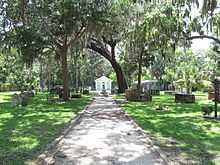
The date of Clarke's death is uncertain, and the place of his burial is unknown. In the section "American Obituraries for 1836" in the American Almanac for 1838, the following entry appears:
Oct. 20, at St. Augustine, Florida, George I. F. Clark, a native of Florida, and for many years Lieutenant-Governor and Surveyor-General of the province of East Florida, under the Spanish Government.
In a bill of complaint filed in chancery court, July 25, 1840, it is stated that:
...on or about the twenty-third day of October Anno Domini Eighteen Hundred and Thirty Six at the City of St. Augustine the said George J. F. Clarke departed this life...
The burial records of the Cathedral archives for 1831-1844 are missing, but according to Louise Biles Hill, the date October 20, 1836, is most likely the correct one.[58] Clarke was probably buried in St. Augustine in the Tolomato Catholic cemetery, on what is now Cordova street, although no vaults or headstones bearing his name have been found. There is no record of his interment in the Bosquebello cemetery of Old Town Fernandina.
References
- ↑ Albert Hazen Wright (1941). Studies in History. A. H. Wright. p. 15. Retrieved 12 July 2013.
- ↑ Hill, Louise Biles (January 1943). "George J. F. Clarke, 1774-1836". The Florida Historical Quarterly (The Florida Historical Society) 21 (3): 187. Retrieved 13 July 2013.
- ↑ United States. Congress. House. House Documents, Otherwise Publ. as Executive Documents: 13th Congress, 2d Session-49th Congress, 1st Session. p. 20.
- ↑ Richard Keith Call; George John Frederic Clarke; John Huertes; Antonio Huertes, Joseph Marion Hernández, United States, United States. Supreme Court (1830). Argument of the Counsel for the United States in the Supreme Court: In the Cases of the United States Vs. George J.F. Clarke, John and Antonio Huertes, Joseph M. Hernández, Et Al. Retrieved 15 July 2013.
- ↑ United States. Supreme Court; Stephen Keyes Williams; Edwin Burritt Smith; Ernest Hitchcock (1883). Reports of Cases Argued and Decided in the Supreme Court of the United States: 1-351 U.S; 1790- October term, 1955. Lawyers' Co-operative Publishing Company. p. 1003. Retrieved 16 July 2013.
- ↑ Workers of the Writers Program of the Works Progress Administration. "WPA History of the Spanish Land Grants". Florida Memory. Division of Library & Information Services Florida Department of State. p. xxvii. Retrieved 13 July 2013.
- ↑ Workers of the Writers Program of the Works Progress Administration. "WPA History of the Spanish Land Grants". Florida Memory. Division of Library & Information Services Florida Department of State. p. xxvi. Retrieved 13 July 2013.
- ↑ Mary Ricketson Bullard (1986). Robert Stafford of Cumberland Island: Growth of a Planter. University of Georgia Press. p. 99. ISBN 978-0-8203-1738-0. Retrieved 15 July 2013.
- ↑ 9.0 9.1 9.2 United States. Congress (1859). American state papers: Documents, legislative and executive of the Congress of the United States ... Gales and Seaton. p. 733. Retrieved 7 July 2013.
- ↑ John Marshall; Institute of Early American History and Culture (Williamsburg, Va.) (1974). The papers of John Marshall. University of North Carolina Press. p. 365. ISBN 978-0-8078-1233-4.
- ↑ Rembert W. Patrick (1 May 2010). Florida Fiasco: Rampant Rebels on the Georgia-Florida Border, 1810-1815. University of Georgia Press. p. 88. ISBN 978-0-8203-3549-0.
- ↑ Robert S. Cotterill (August 1944). "A Chapter of Panton, Leslie and Company". The Journal of Southern History (Southern Historical Association) 10 (3): 275. doi:10.2307/2197938.
- ↑ 13.0 13.1 Joe Knetsch; Southeast Volusia Historical Society (1997). Spanish Land Grants: A Problem for Florida Surveyors : the Case of George J.F. Clarke. pp. 4–5. Retrieved 1 July 2013.
- ↑ Frank Marotti (5 April 2012). The Cana Sanctuary: History, Diplomacy, and Black Catholic Marriage in Antebellum St. Augustine, Florida. University of Alabama Press. p. 17. ISBN 978-0-8173-1747-8. Retrieved 5 July 2013.
- ↑ Marotti 2012, p. 22
- ↑ Jane Landers (1 January 1999). Black Society in Spanish Florida. University of Illinois Press. p. 242. ISBN 978-0-252-06753-2. Retrieved 13 July 2013.
- ↑ Marotti 2012, p. 16
- ↑ Heaven's Soldiers: Free People of Color and the Spanish Legacy in Antebellum Florida. University of Alabama Press. 4 February 2013. pp. 57–58. ISBN 978-0-8173-1784-3. Retrieved 11 July 2013.
- ↑ Jane G. Landers (1 June 2010). Atlantic Creoles in the Age of Revolutions. Harvard University Press. p. 49. ISBN 978-0-674-05416-5. Retrieved 12 July 2013.
- ↑ Legal History of the Color Line: The Rise And Triumph of the One-drop Rule. Backintyme. 1 January 2005. p. 231. ISBN 978-0-939479-23-8. Retrieved 12 July 2013.
- ↑ Marotti 2012, p. 108
- ↑ Landers1999, pp. 242–243
- ↑ Florida Historical Records Survey (1940). Spanish Land Grants in Florida: Briefed Translations from the Archives of the Board of Commissioners for Ascertaining Claims and Titles to Land in the Territory of Florida... State Library Board. p. xxiii. Retrieved 11 July 2013.
- ↑ Workers of the Writers Program of the Works Progress Administration. "WPA History of the Spanish Land Grants". Florida Memory. Division of Library & Information Services Florida Department of State. p. xxiii. Retrieved 13 July 2013.
- ↑ Message From The President Of The United States to The Two Houses of Congress at the Commencement of the First Session of the Twenty-Fourth Congress. 1835. pp. 77–78. Retrieved 13 July 2013.
- ↑ Joe Knetsch, Historian for the Division of State Lands (April 2002). "Impact of Spanish Land Grants on the Development of Florida and the South Eastern United States" Paper delivered at the FIG XXII International Congress, Washington, D.C". p. 6. Retrieved 14 July 2013.
- ↑ Jane G. Landers (2000). Colonial Plantations and Economy in Florida. University Press of Florida. p. 134. ISBN 978-0-8130-1772-3. Retrieved 11 July 2013.
- ↑ Virginia Bergman Peters (April 1979). The Florida wars. Archon Books. p. 37. ISBN 978-0-208-01719-2. Retrieved 16 July 2013.
- ↑ Patrick 2010, p. 92
- ↑ Clarke, George J. F. (October 1925). "The Surrender of Amelia, March, 1812 G. I. F. C". The Florida Historical Quarterly (The Florida Historical Society) 4 (2): 90–95.
- ↑ The Surrender of Amelia, March, 1812 G. I. F. C. The Florida Historical Society Quarterly Vol. 4, No. 2 (Oct., 1925), pp. 91-92
- ↑ Congressional edition 1858, p.45
- ↑ David S. Heidler; Jeanne T. Heidler (2004). Encyclopedia of the War Of 1812. Naval Institute Press. p. 330. ISBN 978-1-59114-362-8. Retrieved 25 April 2013.
- ↑ United States Senate (1860). Senate Documents. U.S. Government Printing Office. p. 70. Retrieved 12 July 2013.
- ↑ James G. Cusick (1 April 2007). The Other War of 1812: The Patriot War and the American Invasion of Spanish East Florida. University of Georgia Press. p. 116. ISBN 978-0-8203-2921-5. Retrieved 12 July 2013.
- ↑ John Lee Williams (1837). The Territory of Florida: Or Sketches of the Topography, Civil and Natural History, of the Country, the Climate, and the Indian Tribes, from the First Discovery to the Present Time. A. T. Goodrich. p. 194. Retrieved 25 April 2013.
- ↑ The Surrender of Amelia, March, 1812 G. I. F. C. The Florida Historical Society Quarterly Vol. 4, No. 2 (Oct., 1925), p. 94
- ↑ Williams 1837, p. 195
- ↑ Charles Blacker Vignoles (1823). Observations Upon the Floridas. E. Bliss & E. White, 128 Broadway, G.L. Birch, Printer, Brooklyn. p. 27. Retrieved 11 July 2013.
- ↑ Junius Elmore Dovell (1952). Florida: Historic, Dramatic, Contemporary. Lewis Historical Publishing Company. p. 131. Retrieved 12 July 2013.
- ↑ Vignoles 1823, p. 22
- ↑ Vignoles 1823, p. 22-23
- ↑ Adam Wasserman (May 2009). A People's History of Florida 1513-1876: How Africans, Seminoles, Women, and Lower Class Whites Shaped the Sunshine State. Adam Wasserman. pp. 160–161. ISBN 978-1-4421-6709-4. Retrieved 4 July 2013.
- ↑ Duvon Clough Corbitt. "The Administrative System in the Floridas, 1783-1821, II: The Government of East Florida, 1783-1821". Tequesta. Historical Association of Southern Florida. p. 63. Retrieved 14 July 2013.
- ↑ Alfred Jackson Hanna; Kathryn Trimmer Abbey Hanna (1950). Florida's Golden Sands. Bobbs-Merrill. p. 43. Retrieved 11 July 2013.
- ↑ Vignoles 1823, p. 23
- ↑ Vignoles 1823, pp. 23-24
- ↑ George J. F. Clarke. "Letter dated May 1, 1823, written by George J. F. Clark from Charleston, South Carolina, to Secretary of State John Quincy Adams". FSU Special Collections, Archives & Manuscripts. Florida State University Libraries. Retrieved 14 July 2013.
...I had the honor of commanding under the Spanish government those ports of East Florida laying west and north of St. Johns River, expecting only Amelia Island, that of Surveyor General, and one of my places of residence was the town of Fernandina when the place fell into the hands of the General McGregor. I was absent at the time, and did not return – it had become necessary for me to keep between him and his successors in farther progression into the province, and to endeavor by every means, to check...the passage of Negro and other cargo piratically acquired and that of dissolute characters thrown together in such scenes of iniquity.
- ↑ Albert Gallatin (1879). The Writings of Albert Gallatin. J.B. Lippincott & Company. p. 250. Retrieved 12 July 2013.
- ↑ Survey 1940, p. xlv
- ↑ United States. Congress (1860). American State Papers: Documents, legislative and executive of the Congress of the United States ... Gales and Seaton. p. 57. Retrieved 12 July 2013.
- ↑ Gen. Joseph M. Hernandez (June 25, 1825). "East Florida Herald". Pensacola Gazette and West Florida Advertiser. p. 3. Retrieved 14 July 2013.
- ↑ John S. Skinner (1827). The American Farmer. p. 337. Retrieved 13 July 2013.
- ↑ 54.0 54.1 James Grant Forbes (1821). Sketches, historical and topographical, of the Floridas, more particularly of East Florida. p. 89. Retrieved 14 July 2013.
- ↑ Professor James D Kornwolf (1 January 2002). Architecture and Town Planning in Colonial North America. JHU Press. pp. 97–98. ISBN 978-0-8018-5986-1. Retrieved 15 July 2013.
- ↑ John McPhee (20 February 1967). Oranges. Farrar, Straus and Giroux. p. 88. ISBN 978-0-374-22688-6. Retrieved 14 July 2013.
- ↑ American Society for Promoting the Civilization and General Improvement of the Indian Tribes within the United States; Jedidiah Morse (1824). The First Annual Report of the American Society for Promoting the Civilization and General Improvement of the Indian Tribes in the United States: Communicated to the Society, in the City of Washington, with the Documents in the Appendix, at Their Meeting, Feb. 6, 1824. Society. p. 35. Retrieved 15 July 2013.
- ↑ Hill 1943, p. 245